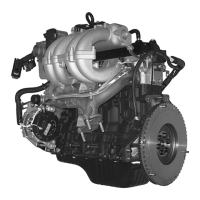TP-6903 5/16a Fuel System Troubleshooting 49
3.3. No Start
Definition: The engine cranks but does not start.
Figure 3-5 No Start Troubleshooting
Checks Action
Preliminary Checks None
ECM Checks
Use Spectrum to :
o Check for proper communication with the ECM
o Check battery power, ignition power and ground circuits to the ECM.
Sensor Checks
Check the TMAP sensor.
Check the crankshaft position sensor for output (rpm). This can be verified by an RPM
signal on Spectrum.
Fuel System Checks
Note: A closed gas supply valve will create a no start condition.
Verify proper operation of the shut-off solenoid valves.
Check for air intake system leakage around the fuel pressure regulator, air-fuel mixer
and throttle body.
Check for air intake system leakage at all connections between the air-fuel mixer and
throttle body on turbocharged engines.
Check the fuel system pressures.
Ignition System Checks
Check for the proper ignition voltage output.
Verify that the spark plugs are correct.
Check the spark plugs for the following conditions:
o Wet plugs (oil fouling)
o Cracks.
o Wear.
o Improper gap.
o Burned electrodes.
o Heavy deposits.
Check for bare or shorted ignition leads.
Check for loose ignition coil connections at the coil.
Engine Mechanical Checks
Check for the following:
o Manifold vacuum leaks.
o Air-fuel mixer vacuum leaks.
o Charge air cooler leaks on turbocharged engines.
o Engine vacuum leaks.
o Improper valve timing.1
o Low compression.
o Improper valve clearance.
o Worn rocker arms.
o Broken or weak valve springs.
o Worn camshaft lobes.
Exhaust System Checks
Check the exhaust system for a possible restriction:
o Inspect the exhaust system for damaged or collapsed pipes.
o Inspect the muffler for signs of heat distress or for possible internal failure.
Check that the turbocharger turbine and compressor blades do not rub or bind against
the turbocharger housing.

